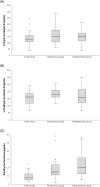Vitamin D status in female dogs with mammary gland tumors
- PMID: 38946311
- PMCID: PMC11256186
- DOI: 10.1111/jvim.17137
Vitamin D status in female dogs with mammary gland tumors
Abstract
Background: Little information exists about vitamin D status in bitches with mammary tumors.
Objectives: To determine whether low plasma vitamin D concentrations are found in bitches with mammary tumors.
Animals: Eighty-five client-owned bitches with mammary tumors (n = 21 benign, n = 64 malignant) and 39 age-matched healthy bitches.
Methods: Case-control study. Plasma ionized and total calcium, phosphorus, magnesium, urea, creatinine, albumin, total proteins, alanine aminotransferase, alkaline phosphatase, parathyroid hormone (PTH), calcitriol (1,25-dihydroxyvitamin D), and 25-hydroxyvitamin D concentrations were measured in all bitches at the time of clinical diagnosis and before any treatments. Statistical analysis was performed to compare variables among groups (control, benign, and malignant).
Results: No significant differences were found when plasma 25-hydroxyvitamin D concentrations in bitches with malignant (148.9 [59.9] ng/mL) and benign mammary tumors (150.1 [122.3] ng/mL) were compared with control group (129.9 [54.5] ng/mL). Parathyroid hormone was significantly higher in bitches with malignant (19.9 [20.5] pg/mL), and benign mammary tumors (14.6 [14.9] pg/mL) compared with control group (7.5 [7.5] pg/mL; P < .01). Only the presence of mammary tumors (P < .01) and age (P = .04; adjusted R2 = .22) was significant in predicting PTH.
Conclusions: Bitches with mammary tumors do not have low 25-hydroxyvitamin D concentrations thus vitamin D supplementation is unlikely to be useful for prevention of mammary tumors in bitches.
Keywords: 1,25‐dihydroxyvitamin D; 25‐hydroxyvitamin D; canine; mammary cancer; mineral metabolism.
© 2024 The Author(s). Journal of Veterinary Internal Medicine published by Wiley Periodicals LLC on behalf of American College of Veterinary Internal Medicine.
Conflict of interest statement
Authors declare no conflict of interest.
Figures

References
-
- Zafalon RVA, Risolia LW, Pedrinelli V, et al. Vitamin D metabolism in dogs and cats and its relation to diseases not associated with bone metabolism. J Anim Physiol Anim Nutr (Berl). 2020;104(1):322‐342. - PubMed
-
- Gerber B, Hauser B, Reusch CE. Serum levels of 25‐hydroxycholecalciferol and 1,25‐dihydroxycholecalciferol in dogs with hypercalcaemia. Vet Res Commun. 2004;28(8):669‐680. - PubMed
-
- Selting KA, Sharp CR, Ringold R, Thamm DH, Backus R. Serum 25‐hydroxyvitamin D concentrations in dogs—correlation with health and cancer risk. Vet Comp Oncol. 2016;14(3):295‐305. - PubMed
MeSH terms
Substances
LinkOut - more resources
Full Text Sources
Medical

